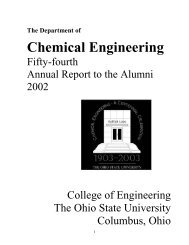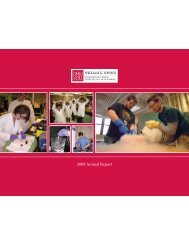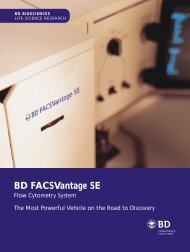Alumni Newsletter - Chemical and Biomolecular Engineering - The ...
Alumni Newsletter - Chemical and Biomolecular Engineering - The ...
Alumni Newsletter - Chemical and Biomolecular Engineering - The ...
You also want an ePaper? Increase the reach of your titles
YUMPU automatically turns print PDFs into web optimized ePapers that Google loves.
the OSU undergraduate students deserve an opportunity<br />
to work <strong>and</strong> learn on an intense <strong>and</strong> meaningful<br />
academic or industrial Process Development project.<br />
<strong>The</strong> project sponsor gains some help in background<br />
reviews, some fundamental lab work <strong>and</strong> some<br />
preliminary economic analysis of a promising project.<br />
<strong>The</strong> senior student learns to apply the learnings from<br />
many of their ChE classes becoming aware of the<br />
whole development process, from the creative spark,<br />
finding the need, <strong>and</strong> justifying the project on economic<br />
grounds. <strong>The</strong> formal report <strong>and</strong> oral presentation to the<br />
class completes the process.<br />
SHELL OIL COMPANY GRANTS<br />
Nilesh Desai <strong>and</strong> Bob Jefferis visited the Department to<br />
present then Chair L.S. Fan with a check for $25,000<br />
for a Shell Oil Grant. <strong>The</strong> purpose of the Shell<br />
Departmental Grants is to strengthen activities in<br />
specified academic areas. Each Departmental Grant is<br />
for use by the senior administrative officer of an area,<br />
as selected by the Shell Oil Company, in each<br />
participating institution. <strong>The</strong> money is to be used in<br />
ways bringing increased strength in the area selected.<br />
<strong>Chemical</strong> <strong>Engineering</strong> selected aerosol research in<br />
conjunction with the hiring of faculty member, Barbara<br />
Wyslouzil, to enhance the research excellence in this<br />
area.<br />
DEPARTMENT NAME CHANGE<br />
Last spring the Department announced a proposed<br />
name change to “<strong>The</strong> Department of <strong>Chemical</strong> <strong>and</strong><br />
<strong>Biomolecular</strong> <strong>Engineering</strong>.” To enact the name change,<br />
the Department had to first petition other departments,<br />
whose students could be affected, for approval. <strong>The</strong>n<br />
the proposal had to be approved by the College of<br />
<strong>Engineering</strong> <strong>and</strong>, finally, the University. <strong>The</strong> name<br />
change will be adopted by Fall Quarter 2004. With the<br />
name change comes a new biomolecular option for ChE<br />
students. <strong>The</strong> option is similar to the existing<br />
environmental option except that certain chemistry<br />
classes are traded for biomolecular <strong>and</strong> molecular<br />
genetics classes.<br />
CHEMICAL ENGINEERING CELEBRATES 100<br />
YEARS AT OHIO STATE<br />
<strong>The</strong> Department celebrated its centennial with the<br />
<strong>Chemical</strong> <strong>Engineering</strong> Centennial Symposium held on<br />
April 24 <strong>and</strong> 25, 2003. On April 24, invited speakers<br />
presented relevant research findings in a series of<br />
presentations focusing on unsolved problems in<br />
chemical engineering, while on April 25, special guests<br />
<strong>and</strong> alumni offered presentations focusing on the<br />
history of the department. A banquet closed out the<br />
event on the evening of April 25.<br />
<strong>The</strong> first chemical engineering program in the country<br />
began at MIT in 1888. Ohio State followed by<br />
establishing a Department of Chemistry in 1902, <strong>and</strong> in<br />
1906 the first bachelor’s degree in chemical<br />
engineering was awarded. In 1924, chemical<br />
engineering became its own department <strong>and</strong> moved into<br />
newly constructed McPherson Laboratory.<br />
NEW PROGRAM SET TO LEAD IN DEVELOP-<br />
MENT OF MICRO- AND NANOTECHNOLOGY<br />
Ohio State has received a $2.9 million research grant<br />
from the National Science Foundation (NSF) to conduct<br />
research in micro- <strong>and</strong> nanotechnology. A new program<br />
entitled Molecular <strong>Engineering</strong> of Microdevices will<br />
lead research in the field of creating these tiny devices.<br />
A micro is a millionth of a meter, <strong>and</strong> a nano is a<br />
billionth of a meter – items the size of DNA.<br />
<strong>The</strong> program is being led by L. James Lee <strong>and</strong> will<br />
focus on two areas of micro- <strong>and</strong> nanotechnology. <strong>The</strong><br />
first is in the area of biotechnology application. <strong>The</strong>y<br />
are developing nano-size devices to deliver medicines<br />
directly into the human body. In the future drugs will be<br />
used by DNA <strong>and</strong> devices will be needed to deliver<br />
those drugs. An example of a disease that could benefit<br />
from a nanotechnology delivery system is diabetes. A<br />
diabetic who takes five shots of insulin per day would<br />
be able to use the nanotechnology to deliver the insulin<br />
directly to the needed areas. Nanotechnology would<br />
also be used in the area of tissue regeneration.<br />
<strong>The</strong> second area nanotechnology research will impact is<br />
the automotive industry where it can help lower<br />
emissions <strong>and</strong> improve energy efficiency <strong>and</strong> engine<br />
performance. New nanotechnology can also utilize









